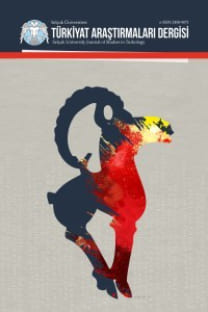Tarihin Nesnesinden Kurmacanın Öznesine Şeyh Bedrettin Yahut Tarihsel Bir Kimliğin Yeniden İnşası Üzerine
Osmanlı tarihinde Fetret Devri olarak adlandırılan 1401–1413 yılları arasında yaşanan siyasîolaylar içinde önemli bir yere sahip olan Şeyh Bedreddin isyanının tarihî süreç içinde hafızalardacanlı kalması, onun siyasî, toplumsal ve dinî görüşlerinin faklılığından kaynaklanmaktadır.Resmî Osmanlı tarihçilerinin birçoğunun devlete isyan etmiş ve sapık fikirlere sahip birasi olarak değerlendirdikleri Şeyh Bedreddin, düşünceleriyle modern siyasal ideolojiler açısındanyeniden önem kazanmış ve bu bağlamda farklı farklı yaklaşımlar ortaya çıkmıştır. Tarihinilgisini çektiği kadar romancıların da ilgisini çeken Şeyh Bedreddin’i konu edinen Türk romanlarında,yazarların dünya görüşlerine ve ideolojilerine bağlı olarak şekillenen çeşitli Bedreddinimgeleri kurgulanmıştır. Bu imgeler üzerinden anlatılan Şeyh Bedreddin, yer yer resmî Osmanlıtarihinin anlattığı imgeye yaklaşırken bazı romanlarda ise, onun bu resmî algının çokuzağında bir imgeye dönüşmüş olduğunu görürüz.
Şeyh Bedreddin: From Object of History to Subject of Fiction or On the Reconstruction of Historical Identity
The fact that Şeyh Bedreddin rebellion which has an important place in the political events between 1403 1413 called as interregnum on Ottoman Period has always been remembered throughout history is mostly due to differences in its political, social and religious views. Şeyh Bedreddin whom many of the official historians of the Ottoman regarded as a rebel, who stood against the state and had perverted ideas, has gained importance with his ideas in terms of modern political ideologies, and different approaches have emerged in this context. In Turkish novels which took Şeyh Bedreddin, who attracted the interest of novelists as well as the attention of history, as their subject matter, various Şeyh Bedreddin images were created, shaped by the authors' world views and ideologies. Described through these images, Şeyh Bedreddin while sometimes getting closer to the image told by the official Ottoman history,in some novels we see him turning into an image far from this official perception
Keywords:
Şeyh Bedreddin, history, literature, novel, ideology, image,
- ISSN: 1300-5766
- Yayın Aralığı: Yılda 3 Sayı
- Başlangıç: 1994
- Yayıncı: Selçuk Üniversitesi
Sayıdaki Diğer Makaleler
Afet (Muhteremoğlu) Ilgaz'ın Romanlarında "Aşk"
Televizyon Haberlerinde Söylem-29 Mart 2009 Yerel Seçimleri Örneği-
Afet (Muhteremoğlu) Ilgaz'ın Romanlarında "Aşk"
Dokuzuncu İskân Mıntıkası ve Kadro Cetvelleri
Ming tarih Kayıtlarına Göre 16. Yüzyılda Osmanlı İmparatorluğu-Ming Çin'i İlişkileri
Osmanlı Devleti'nin Son Döneminde Yol Vergisi (1866-1921)
"Haydi, Hadi, Hayda" Kelimeleri Üzerine
Tarihi Yeniden Kurma Kuramı: Veli Baba Üzerine Anlatılan Efsaneler
